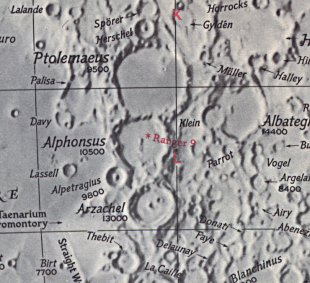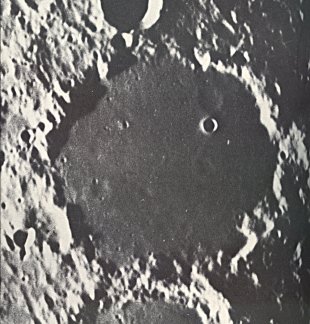

I have been fortunate to have observed a Lunar Ray in the crater Ptolemaeus last Saturday evening (09/29/2002). A kind fellow Mr. Dave Mitsky recommended that I relay the observation to you.
The first order of business was to look for favorable libration of mare orientale, but when i focused in on the moon i was struck by the obvious sight of a lunar ray in ptolemaeus. Dead center of the terminator, and lunar disk, i could see the large crater had a fan shaped spray of light emanating from around 9°s, and 5°w. The lowered crater rim was due west of the center and north of ptolemaeus e. the fan shaped ray extended east over most of the floor of the crater and highlighted the craterlet m and just met the western rim of ptolemaeus a (ammonius). Bits and pieces of the eastern rim of ptolemaeus were still illuminated, even past the pointed crumbled east edge. Other striking formations in the area were the central peak of alphonsus just south of ptolemaeus, and a long sinuous fault line 8-10° southwest of ptolemaeus. The ray had lessened by about 7ut and was barely half way across the crater floor when i started at the rest of the lunar project.
David Ryle 33.82479W Long 98.54455N. Wichita Falls, Texas 8" f/6 reflector at 30x, 38x, 47x, 94x, & 260x
The Initial Predictions, Using Data in Original Reporting
The date and time given for the observation was 9/29/02 UT at around 7:00UT. Since in his report, he states that the ray had lessened by 7:00UT, the initial predictions is moved up to 5:00UT to possibly catch the ray at an earlier time. The initial circumstances are what will be used to generate predictions for future events. A colongitude of 181.398 with a solar altitude of .397 setting will be used.
Feature = Ptolemaeus Feature Longitude: = -1.800 Feature Latitude: = -9.200 Reproducing Lighting For: 2002/9/29 at 05:00 U.T. Desired Solar Altitude = +0.397(Setting), Azimuth = +271.496 Average Co-longitude = 181.398
Ptolemaeus: -048,-158; A great walled-plain, over 90 miles in diameter, and very favorably placed for observation near the center of the disk, with complex and, in part, discontinuous walls, divided by valleys and passes into separate mountain masses, with numerous spurs, and projections onto the interior... (Wilkins and Moore, The Moon, 1055, Faber and Faber Ltd, London, p. 60)

